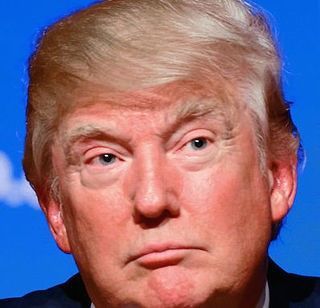Bullying
The Trump Effect: An Update
The toxicity is spreading.
Posted January 30, 2018 Reviewed by Gary Drevitch

Last spring we wrote a two-part post about “The Trump Effect,” which was originally defined as an increase in bullying in schools caused by the rhetoric Donald Trump used during his presidential campaign. Now, a year into Mr. Trump’s presidency, the definition of The Trump Effect has expanded to include religious and racial bullying by adults as well as: misogyny, sexual assault, and other socially unacceptable behaviors.
To be clear, bullying is not a partisan issue; it is a behavior described as the use of power through strength or influence to intimidate another. It is practiced not only by humans, but by primates and other mammals. In the animal kingdom, where pecking order is an important aspect of survival, bullying can lead to shunning, beatings, expulsion from a troop of chimpanzees or congress of baboons, and ultimately even death of the victim. Unfortunately, the same behavior and its varying outcomes are also too true of humans.
However, we humans are more complex thinkers than our primate friends. For instance, we've taken an aspect of the pecking order and devised a complicated system of governance that includes a full spectrum of beliefs and ways of thinking that have been squeezed into two major political parties (Republican versus Democrat.) After 240 years since the birth of America as a unified nation, we find ourselves at a crossroads of divisiveness that hasn’t been experienced in decades, if not for centuries. One of the most alarming facets of our current political climate is how partisan ideologies, when coupled with a tendency to bully, can lead to extremely harmful bullying.
Update on The Trump Effect in our schools
The Human Rights Campaign (HRC) recently presented its alarming results of it's national post-election survey of the effects of Trump's bully behavior. The HRC cites a rapid increase in youth bullying during and since the 2016 campaign. “HRC surveyed a diverse group of 50,000 youth, ages 13 through 18, and found that 70 percent of respondents had witnessed bullying, which included hate messages or harassment throughout the campaign period and in the immediate aftermath of Trump’s election victory. Among those who witnessed the bullying, ‘79 percent said it occurred more frequently following the start of the campaign.’ The bullying effects of the Trump presidency—dubbed the Trump effect—are devastating, particularly when it comes to bullying of minority groups, especially those who are easily identifiable and/or who are singled out by the president’s statements or actions.”
The HRC survey echoed Maureen Costello’s earlier report produced for the Southern Poverty Law Center’s (SPLC) Teaching Tolerance program in which two thousand K-12 teachers participated. The on-line survey was conducted to determine the effect of bully rhetoric during the 2016 presidential campaign on children. The results revealed that the campaign had a “profoundly negative effect on children and classrooms.” Further, the report showed “a disturbing nationwide problem, one that is particularly acute in schools with high concentrations of minority children.”
While immigrant students, children of immigrants (close to one-third of children in U.S. classrooms are children of foreign-born parents), and students of color and their friends were fearful, many children were not afraid at all. Rather, some used the word “Trump” as a taunt or chant as they ganged up on others. Teachers reported that students were emboldened to use slurs and make inflammatory statements toward each other. Name-calling, threats of deportation, and worse, have caused some of the bullied children to suffer panic attacks and to even entertain suicidal thoughts.
Many of the gains made by years of anti-bullying work in schools (see NoBully.com) have been lost since the 2016 presidential election. But a consistent theme across grade levels emerged: students understood the behavior on display by the president was not okay. We have to add that our research reveals another negative fallout of bullying, beyond its targeted victims—the people who witness it and do nothing—as passive bystanders. Many of them feel prolonged shame for their inaction against injustice experienced by friends and classmates. They are guilty of the evil of inaction when it was readily possible to show compassion that can transform into taking heroic action to help others in need.
Long-term impact
It may be impossible to determine the long-term impact of these damaging experiences to children’s well-being, but clearly these students continue to be stressed and anxious. The dangerous effect of bullying on children is well-known: it affects academic achievement, health, and in some cases, can lead to self-harm. Stressed students have a more difficult time learning and anxiety has a deleterious impact on concentration and therefore grades. But whether or not a student is a member of a targeted group, all students witnessing it in action are vulnerable to the stresses of The Trump Effect.
As children are a reflection of their upbringing, more than likely, the angry acting-out of some students toward others in our schools is a reflection of what they observe in their homes. For years, schools have implemented comprehensive policies and programs to prevent and address bullying. And in many schools, these programs have made a real difference in creating a culture of respect. Unfortunately, due to the erratic actions of one man and his negative effect on some children’s caretakers, much of that hard work has been undone.
How bullying begets complicity
In the schoolyard, when the bully and his/her minions gang up on a student, the victim may, from that point forward, cringe and try to disappear whenever the bully materializes. (As the victim’s self-esteem plummets, the bully’s increases.) In some instances, as a self-preservation strategy, the victim may reluctantly join the bully’s gang, if the bully agrees. (This may lower the victim’s self-esteem or conversely, cause an uptick due to social acceptance. Concurrently, the bully’s increases.) While in other instances, the victim may try to divert the bully’s attention by turning on a different possible victim in an attempt to take the heat off themselves. (The initial victim’s sense of relief may override feelings of guilt at causing another person’s victimization.) In the meantime, the witnessing bystanders who do nothing to correct the situation become, through their inaction, complicit in the bully’s activity. This inadvertent complicity allows the bully behavior to continue.
In 2018, these same schoolyard bully tactics and behaviors can be applied to our current governance. If we set political affiliations aside and observe only the comportment of some of our government lawmakers, bully-victim behavior emerges. Here’s how it works: A bully in power who has an already established penchant for using social media to damage others doesn’t need to threaten a subordinate to make them do what the bully wants. The victim is aware of the bully’s past behavior -- and the results -- so the impending threat of a negative tweet or statement about the intended victim is enough to keep the victim squelched or “in line.” As is happening in our schoolyards by witnessing bystanders, being “in line” may mean keeping silent instead of speaking out against injustice.
What to do?
Free speech and expressing our opinion is a constitutional right. It’s up to others whether or not they want to listen. But when the speaker is POTUS, we all listen. And when the president’s use of provocative rhetoric that causes harm to others, including and especially innocents, or when he behaves in previously unacceptable ways, what can we do? What should we do?
First, we can realize the only person we have control over is ourselves. We control what we think, what we choose to say, and how we act and react. We can choose to be harsh and damaging, or to be kind and compassionate. Next, we can pay better attention to the actions, reactions, and behaviors of others, including our officials and appointees. Are they bullies, or are they victims? And if they are victims, how are they reacting? As our Founding Fathers intended, "for the good of all"? Or for their own personal benefit?
No matter what we choose, our children notice our actions, good or ill. And like the children mentioned in the studies above, we understand the behavior on display by our president and his yes-men is not okay. It is really much more like what we saw in earlier generations witnessing the rise of fascism.
References
Uddin, A. (2018). It's Time We Talk About the 'Trump Effect on Kids: It's a major issue. Teenvogue.com.
Goodall, J. (1986). Social Rejection, Exclusion and Shunning Among the Gombe Chimpanzees.California Academy of Sciences. sciencedirect.com.
Costello, M. (2016). The Trump Effect: The Impact of the Presidential Campaign in our Nation's Schools. Southern Poverty Law Center.
Lee, B., et al (2017). The Dangerous Case of Donald Trump: 27 Psychiatrists and Mental Health Experts Assess a President. MacMillan.




